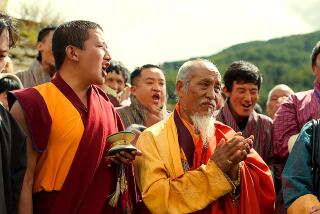‘Little Buddha’s’ Sense of Wonder Is No Small Thing
- Share via
Bernardo Bertolucci’s new film, “Little Buddha,” is an extraordinary achievement by a master director in ways that cannot be seen in Kenneth Turan’s review (“Buddha: Terminal Bliss,” Calendar, May 25). The proposition that “Little Buddha” is distorted by Bertolucci’s “New Age reverence” for Buddhism is simply not accurate. It is important to understand that Buddhism is arguably the least monolithic of world religions as there are quite divergent schools that share a common basis but differ in many views and practices. The vajrayana Buddhism of Tibet, Bhutan, Nepal and northern India is the basis for “Little Buddha” and the filmmakers have studied this tradition well and have presented it authentically.
As a practitioner of vajrayana Buddhism for 25 years and director of the America Bhutan Council, it was of great interest to me to discuss these traditions with Bertolucci, producer Jeremy Thomas and others involved in the film. They had not only delved quite deeply into the subject, but they were also painstakingly careful to consult with the film’s technical adviser (a highly respected Tibetan Buddhist teacher who was present at all times) on every point of doctrine or visual representation of the tradition. Although the central Buddhist monk in the film was a professional actor, all others are real-life important vajrayana Buddhist teachers who, in my experience, are just as they seem in the film.
The review questions the meaning of the word little in the title and doubts Bertolucci’s understanding of why he used it. This is an interesting point since the use of the diminutive in referring to Buddha has provoked much controversy. In vajrayana Buddhism there is a millennium-long tradition of discovering and training young children who are regarded as incarnations of great teachers. The Dalai Lamas and Karmapas are among the best known of thousands of such children referred to in Tibetan as tulku , meaning buddha or “one who is awakened.” It is a mark of Bertolucci’s perceptiveness and sophistication that he does understand this meaning of “little buddha” and applies it correctly to the American child at the center of the film.
Most notably, Bertolucci manages to recount a fascinating story based on real people and events while at the same time conveying to Western audiences an accurate and compelling historical, philosophical and visual experience of a 2,500-year-old tradition. He does this in a ravishingly beautiful display and in only two hours. Quite an accomplishment!
*
“Little Buddha” also brings the little-known and magnificent land and people of Bhutan to Western audiences. Bhutan has managed to maintain an ancient and exquisite culture and is the most unspoiled country on the face of the Earth. Surrounded by other Himalayan nations such as Tibet, Sikkim and Nepal, which have fallen to larger neighbors or been overrun by development, Bhutan is engaged in a struggle to preserve its heritage and way of life. The American Bhutan Council was founded to assist Bhutan in the heroic effort to retain its indigenous traditions. Bertolucci’s sensitive and authentic portrayal of that culture is a great gift to the world.
Bertolucci has made a magnificent film in a daring and bold attempt to convey something more thought-provoking and uplifting of the human spirit than virtually anything else in cinema today. He has succeeded in creating an artistic gem that deeply touches the heart. Turan’s estimation of “Little Buddha” as being a “children’s film” is far wiser than he may know. The profound teachings of Buddhism are all about cultivating “beginner’s mind,” about seeing reality with the openness and wonder of a child. That Bertolucci has succeeded in conveying this speaks volumes about the triumph of his skills and his understanding.
More to Read
Only good movies
Get the Indie Focus newsletter, Mark Olsen's weekly guide to the world of cinema.
You may occasionally receive promotional content from the Los Angeles Times.










